Alaska Fish & Wildlife News
February 2022
A Bear by Any Other Name
The Many Monikers of Ursus arctos Part 2
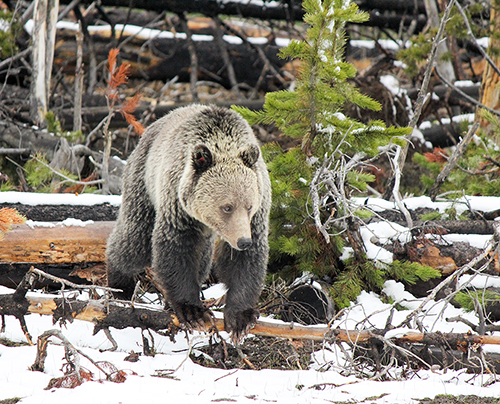
As we saw last month, the road to understanding how to best categorize the brown bears of Alaska has not been straightforward. From Lewis and Clark’s “discovery” of the “grizzly” to C. Hart Merriam’s assertion that over 70 unique species of brown bear inhabited North America, the path to taxonomic clarity has been full of twists, bumps, and occasional U-turns. By the late 20th century, however, there was unanimous agreement with Robert Rausch’s assertion that all brown and grizzly bears of North America, Europe, and Asia belonged to one single Holarctic species: Ursus arctos.
In spite of this consensus, disagreement lingered regarding how many subspecies of brown bear exist throughout mainland Alaska. Should the smaller “grizzly bears” of interior and northern Alaska be considered distinct from the larger “brown bears” found along the southern coast? And should coastal bears be further subdivided depending upon their location?
These disagreements were due to different opinions formed from morphometric data - the measurements taken from bear skulls. After nearly a century of such measurements serving as the primary basis for taxonomic designation, researchers found themselves with new tools that would provide insights that no calipers or ruler ever could.
What Do Genes Have to Do With It?
The discovery of the double-helix structure of DNA in 1953 changed biological sciences forever. New disciplines shifted the paradigm regarding what criteria should be used to understand and describe the relationships between organisms and categorize them in the taxonomic tree of life. Instead of just looking at an organism’s phenotype (the readily observable characteristics of an individual), now it was possible to examine the genotype of an organism (the genetic material inherent to an individual) and compare it to others.
By the 1990’s, biologists were looking into the genetics of brown bears to better understand their evolutionary development and diversification and to settle disputes regarding the number of subspecies. Examination of mitochondrial DNA (abbreviated as mtDNA) from bears sampled all across Alaska revealed some surprising results.
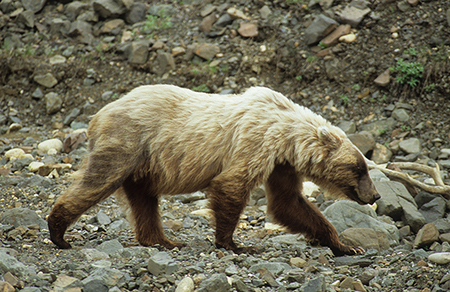
Firstly, the genetic data did not support any of the proposed subspecies designations, which either considered all mainland bears to be essentially the same, or suggested that coastal and interior bears were somehow distinct. What was revealed instead were three different genetic groupings or “clades,” inhabiting different regions (clade - from the Greek word for branch - refers to a group of organisms believed to have evolved from a common ancestor).
One clade inhabited most of Alaska, from the Alaska Peninsula to the western North Slope, and throughout the Interior down to the Kenai Peninsula. A second clade was found in eastern Alaska, from Prince William Sound up through the Wrangells and Fortymile country to ANWR, and down along the mainland of the Southeast Panhandle. The final clade had the smallest distribution, found only on the Southeast islands of Admiralty, Baranof, and Chichagof (the ABC Islands).
This third clade proved unusual in more than just its limited distribution. When examining the mtDNA from the ABC Island bears, researchers found that it had a small but distinct percentage of DNA from polar bears (Ursus maritimus). How could that be possible?
The leading hypothesis suggests that during the ice age when glaciers and sea ice were at their maximum, pack ice extended as far as Southeast Alaska. Polar bears roamed the southern fringes of the ice and the adjacent landscape. Sea levels were much lower, and parts of what are now the ABC Islands, along with now-submerged adjacent coastal lands, were populated with a variety of animals. When the glaciers and sea ice receded about 16,000 years ago, a remnant population of polar bears remained. Male brown bears migrating from the mainland into this newly habitable Southeast Alaska encountered that relic population and interbred with them.
Brown bears and polar bears are close relatives and have been known to hybridize both in captivity and the wild, resulting in fully fertile offspring. With a drawn-out yet steady influx of brown bears colonizing the islands, over time the polar bear genes became more diluted, and this population came to exhibit the phenotypes (observable characteristics) of other brown bears.
There is no evidence of comparable brown bear DNA in any population of polar bears, implying that those interbred polar bears did not mix with the larger polar bear population.
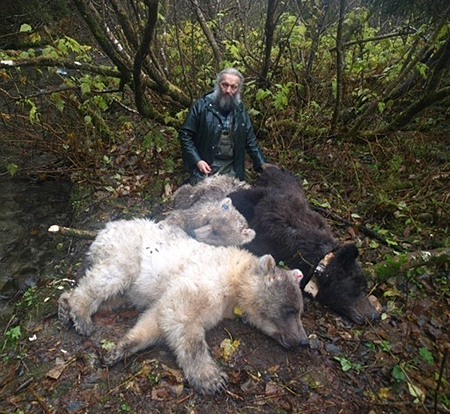
Does this remarkable genetic history mean that the ABC bears deserve designation as a unique subspecies? And would it then follow that the other two clades also deserve subspecies status?
Well, not so fast.
The early studies focused on mitochondrial DNA, which is passed down only from a mother to her offspring. For bears - as with all mammals - it takes two to tango, and thus maternally-derived mtDNA only tells half of the story. The vast majority of DNA in a cell is not in the mitochondria, but within the cell’s nucleus, and this is inherited from both parents. When nuclear DNA from bears across Alaska was examined, a different picture emerged.
Populations in mainland Alaska were not found to be genetically isolated from adjacent populations, including the ABC bears, with genes flowing freely between both coastal and inland populations as well as between populations belonging to the “eastern” and “western” mtDNA clades. Animals can be identified genetically as belonging to distinct populations and clades, and as might be expected, the genetic distance between any two bear populations was found to be a function of physical distance and intervening geography. This supported Rausch’s original assertion that only one brown bear species is found throughout mainland North America.
These two different pictures produced from examining mtDNA and nuclear DNA are a function of brown bear behavior. When young adult bears leave the care of their mothers and make their own way in the world, there is a significant difference in dispersal behavior between the sexes. Female bears do not tend to travel far from where they grew up, and establish home ranges adjacent to or even overlapping those of their mother. Male bears, on the other hand, tend to strike out on much longer journeys, generally traveling dozens of miles – and sometimes much further – before settling down.
This behavior likely evolved as a means to avoid inbreeding, and this is borne out in the results of the genetic studies. The mtDNA - passed from mothers to their cubs - shows strong regionalism, as related females slowly spread out over the landscape over time. The nuclear DNA - half of which comes from the father – clearly shows the genetic exchange between adjacent regions and populations due to the wider dispersal patterns of males.
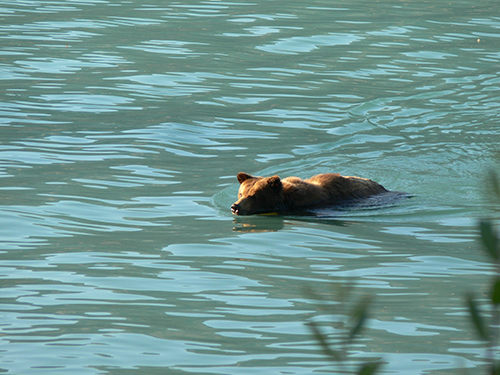
This fits with the polar bear mtDNA found in ABC Island bears. Given the propensity of females to remain near the home range they grew up in, island females were unlikely to disperse very far, and mainland females were unlikely to move onto the islands. Males occasionally struck out from the islands to the mainland, but their unique mtDNA could never be passed on to any offspring they sired, as their cubs would inherit the mtDNA of their mainland mothers. This pattern of female fidelity and periodic male dispersal is still evident on the ABC Islands today.
What about Kodiak Bears?
The brown bears of the Kodiak Archipelago have long been viewed as a separate subspecies. Due to their geographic isolation and unique physical characteristics (large average size and relatively wide skulls), it was surmised that Kodiak bears differed significantly from mainland bears genetically.
Investigations haven’t supported this, however. While they do exhibit lower overall genetic diversity compared to mainland populations and some possess a few unique genetic markers, these markers are not found universally within the population, and thus cannot be used to definitively separate Kodiak bears from those on the mainland. Furthermore, examination of mtDNA from Kodiak bears places them neatly within the “western Alaska” mtDNA clade, being more closely related to some mainland populations than far-flung mainland populations are to each other.
Should Kodiak bears be considered a separate subspecies? At present, the answer seems to be the same as it has been throughout our story: it depends on who you ask. According to the Integrated Taxonomic Information System - a taxonomic database formed through the partnership of various federal agencies of the U.S., Canada, and Mexico – there are a total of six brown bear subspecies in Alaska. But speak with most bear biologists or bear geneticists, and you will likely be told that only one, or at most two, subspecies inhabit the 49th state.
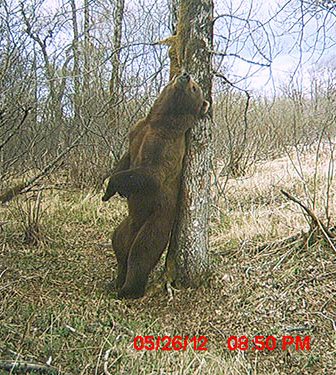
ITIS’ data is based upon work on brown bear systematics published in the 1980’s, based on skull morphometrics and conducted before many of the bear genetics studies. But since this work is the most recent publication formally putting forth subspecific proposals, it serves as the de facto “official” view among taxonomic circles. As we have seen, genetic evidence does not back up these designations, and perhaps a revised view of Alaskan brown bear systematics will be submitted in the future.
Taxonomy, like most facets of the biological sciences, is constantly in motion. Brown bear taxonomy has come a long way since the days of Lewis and Clark, but there is still much to be resolved and more unexpected discoveries will be made as new methods of inquiry are devised. Stay tuned.
Breeding, Feeding, and Regional Size Disparities
If you’ve made it this far, you may be asking yourself what this has to do with the traditional notion of coastal “brown bears” and interior “grizzlies.” If the genetic data doesn’t support any delineation between the two, then why do they look so different? Why are coastal bears bigger?
Diet is the common answer, and while that certainly plays a role, in truth the full picture is a bit more nuanced. It suggests coastal bears attain large sizes due to access to rich food sources such as sedge grass, seasonal salmon runs, and the occasional beached whale. Interior and northern bears on the other hand, subsist more heavily on roots, vegetation, berries, and ground squirrels, do not grow nearly as large.
This implies that all bears would reach the same general size if given access to the same resources, but examples provided by orphaned, wild-born bears housed in captivity indicate that this is not the case. When bears from interior or northern portions of the state are raised alongside bears from southern coastal areas, interior bears still tend to grow to be smaller adults, despite eating the same diet and growing up in the same environment. So other factors are contributing to a bear’s final dimensions.
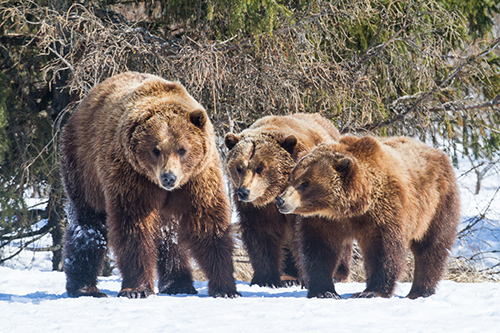
The appearance of an organism is based upon the interaction of genetics and environment. Although brown bears throughout Alaska don’t differ much genetically, the difference is a matter of degree. While the variation is not great enough to suggest taxonomic delineation, it is possible to identify an individual bear’s population of origin by looking at its genetic makeup. Different populations have different genetic characteristics, and some of these translate into different adaptations to local ecological conditions.
As an example, consider the Brooks Range, where some of the smallest brown bears in the state are found (adult males weigh from 400 to 600 pounds). Here food is relatively scarce and winter is long; adult bears often need home ranges over 1,000 square miles to find adequate resources and may spend half to three-quarters of any given year subsisting off of fat reserves as they hibernate.
Brooks Range bears are not small simply because they don’t have access to plentiful, high-quality food sources. They are small because over countless generations inhabiting the Brooks Range, bears with a smaller stature have held a competitive advantage. Smaller body size equates to lower caloric needs and less fat that needs to be accumulated each summer in order to sleep through the long winter. It is also much easier to travel the large distances necessary to find sufficient food without carrying around a lot of extra bulk, and over time Brooks Range bears have adapted smaller body sizes to best fit the ecological conditions.
This is natural selection, where individuals with the traits best suited to the local environment have the greatest chance of surviving to pass those traits on to future generations.
Now what about bears on the opposite end of the size gradient, like those on Kodiak Island and the Alaska Peninsula (where males can weigh from 800 to 1,400 pounds)? Here conditions are much more hospitable, with shorter, milder winters and rich, consistent, and accessible food sources. If genetics are playing a role, it implies that there is some selective advantage to being big, and in this case it isn’t related to food, but to that other great concern of biology: reproduction.
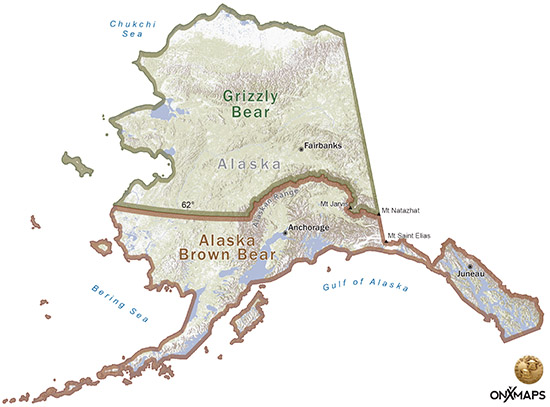
Among brown bears, the mating system is pretty straightforward: males seek out females in estrus, and if there are no other males around, the two will likely mate. If there are other males around, it is often the biggest male who gets the female (or multiple females), either through intimidation or outright physical combat with the other suitors.
In areas where food is plentiful and bears are not nutritionally limited, population densities are high and there is increased competition for mating opportunities. This provides a distinct selective advantage to larger males, who are able to breed more often than smaller males. Large males sire large cubs, and since the plentiful food resources required to maintain a large body are available, the average body size for the population trends upward until either environmental or biological constraints stabilize it (i.e. too large of a body begins to affect survival rate, or bears simply cannot attain larger sizes).
This process, where traits are shaped primarily through interactions affecting reproduction, is called sexual selection, and is most likely a driving force behind the large size observed in Alaska’s coastal bears. This can be illustrated by examining the degree of sexual dimorphism (the differences observable between the two sexes) evident in different populations of bears throughout the state.
As a species, brown bears exhibit sexual dimorphism generally; males tend to be larger than females. The degree of this size difference, however, varies from region to region. In areas such as the Alaska Peninsula, high bear densities intensify competition for mates and males tend to be significantly larger than females (who themselves tend to be large). On the other hand, in areas like the Brooks Range where habitats are more nutritionally limiting, bear densities tend to be low, sexual selection for large body size among males is relaxed, and sexual dimorphism is diminished as the increased selection pressures of the environment tend to favor bears of a similar size.
Thus, the average size and degree of sexual dimorphism observed within any population of brown bears is the product and “optimal solution” of two opposing forces: sexual selection via population density pushing for larger body size, and environmental selection via habitat quality and resource availability limiting how large a bear can get.
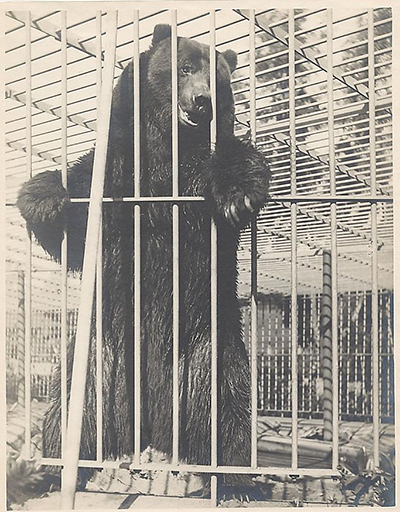
The patterns observed in Alaska have occurred independently in many different parts of the brown bear’s range, reinforcing the notion that the differences between coastal and interior bears are due to a complex interaction of genetics, food availability, and population density, and not simply due to diet or genetics alone.
The extinct coastal grizzlies of southern California, for instance - with high population densities made possible by a mild climate and plentiful food sources like oak mast, manzanita berries, and beached marine mammals – grew to such large sizes and exhibited such stark sexual dimorphism that C. Hart Merriam compared them to Kodiak bears in his 1918 monograph. Photographs of some of the last living representatives of this population depict bears that resemble coastal Alaskan brown bear - despite genetic data indicating these bears had a closer genetic relationship with bears of the continental United States than either did with the bears of Alaska.
With this in mind, why does the distinction between interior “grizzlies” and “coastal brown bears” still persist in the Last Frontier? To make what has proven to be a long explanation short, it really just comes down to one simple word: tradition.
Regardless of whether we call it a grizzly bear, a brown bear, or Ursus arctos, it doesn’t change what the animal actually is. It is a creature whose very tracks can make a favored fishing hole seem unsettling, an alder thicket more foreboding, and a rustling heard in the darkness outside the tent downright nerve-racking. But it is also a creature whose same tracks can enliven a walk in the woods or across the tundra beyond measure, instilling in those who happen upon them a sense of delight, exhilaration, and gratitude for wild places where all seems as it should be.
Wilson Puryear is a Fish and Wildlife Technician who works primarily at the Sport Fish Information Center within ADF&G’s Anchorage office.
Subscribe to be notified about new issues
Receive a monthly notice about new issues and articles.
